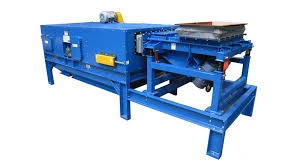
10 月 . 11, 2024 20:59 Back to list
Understanding Aluminium Eddy Current Separation A Comprehensive Overview
Eddy current separation is a powerful technique used in recycling and material sorting, particularly for non-ferrous metals like aluminium. This process takes advantage of electromagnetic fields to differentiate materials based on their electrical conductivity and magnetic permeability. As the demand for more efficient recycling processes grows, understanding eddy current separation becomes increasingly essential.
The Principle of Eddy Currents
Eddy currents are loops of electric current that are induced within conductors by a changing magnetic field. When a conductive material, such as aluminium, is subjected to a magnetic field, electrical currents are generated within it. These currents create their own magnetic fields that oppose the initial magnetic field, a phenomenon described by Lenz's Law. The resulting interaction can cause the material to experience a force that may cause it to move. This principle is the cornerstone of eddy current separation technology.
The Eddy Current Separator
An eddy current separator consists of a rotor with a series of magnets that produces a rapidly alternating magnetic field. When non-ferrous metals like aluminium pass through this field, the induced eddy currents generate repulsive forces that propel the material away from other waste materials. As a result, aluminium can be efficiently separated from heavier, non-conductive materials, such as plastics or glass, and from conductive but less valuable metals like steel.
Applications in Recycling
The eddy current separator has gained significant traction in recycling industries. With the escalating global focus on sustainability and the circular economy, recycling processes must be both effective and efficient. Eddy current separation aligns with these goals by allowing for high recovery rates of valuable non-ferrous materials like aluminium.

For instance, in scrap metal yards, eddy current separators can process a stream of mixed metals. The rapid separation of aluminium from other materials ensures that it can be easily reused or processed for refining, resulting in substantial economic and environmental benefits. Moreover, aluminium is a highly sought-after material due to its lightweight properties and resistance to corrosion, making its recovery particularly advantageous.
Efficiency and Environmental Impact
Using eddy current separation enhances not only the efficiency of material recovery but also minimizes waste and energy consumption associated with traditional processing methods. For example, the energy required to mine and refine aluminium is significantly higher than that needed for recycling. Therefore, recovering aluminium through eddy current separation contributes positively to environmental sustainability by reducing energy usage and greenhouse gas emissions.
Additionally, the technology supports the transition towards a circular economy, where materials are continuously reused and recycled. It ensures that valuable resources like aluminium do not end up in landfills, which reduces the overall environmental footprint and promotes resource conservation.
Challenges and Innovations
While eddy current separation is highly effective, it is not without challenges. The technology must be fine-tuned to handle various types and sizes of materials, as well as to work effectively in diverse operational environments. Innovations in sensor technology and machine learning are continually enhancing the precision and efficiency of eddy current separators. Advanced algorithms can analyze material composition more accurately and adapt the separation process in real-time, thereby improving overall performance.
Conclusion
Eddy current separation is an invaluable technology in the modern recycling landscape, particularly for non-ferrous metals like aluminium. By understanding the principles behind this process and recognizing its applications, industries can better leverage its capabilities to foster sustainable practices. As technology continues to evolve, the efficiencies of eddy current separation will only improve, making it an essential tool in the quest for a more sustainable future. With increased focus on recycling and resource recovery, eddy current separation offers a pathway not only towards economic viability but also towards responsible stewardship of our planet's resources.
Latest news
Unveiling the Power of Eddy Current Separator
NewsSep.25,2024
Transform Your Home Recyclin:home metal shredder
NewsSep.25,2024
The Future of Waste Management with Recycling Line Picker
NewsSep.25,2024
The Benefits of a Metal Recycling Plant
NewsSep.25,2024
Revolutionize Material Separation with Onwang Technology
NewsSep.25,2024
Innovative Waste Management: Unveiling the MSW Sorting Plant
NewsSep.25,2024